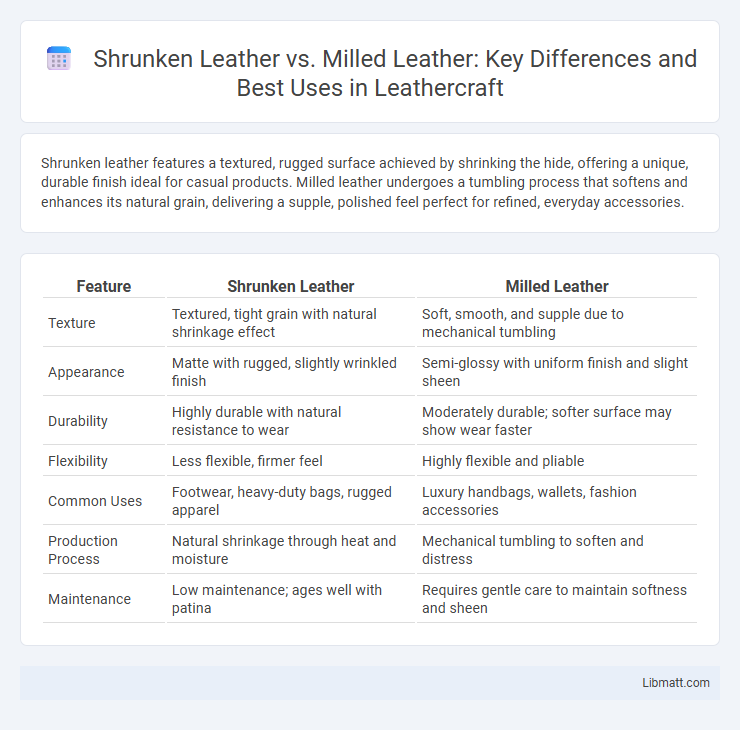Shrunken leather features a textured, rugged surface achieved by shrinking the hide, offering a unique, durable finish ideal for casual products. Milled leather undergoes a tumbling process that softens and enhances its natural grain, delivering a supple, polished feel perfect for refined, everyday accessories.
Table of Comparison
| Feature | Shrunken Leather | Milled Leather |
|---|---|---|
| Texture | Textured, tight grain with natural shrinkage effect | Soft, smooth, and supple due to mechanical tumbling |
| Appearance | Matte with rugged, slightly wrinkled finish | Semi-glossy with uniform finish and slight sheen |
| Durability | Highly durable with natural resistance to wear | Moderately durable; softer surface may show wear faster |
| Flexibility | Less flexible, firmer feel | Highly flexible and pliable |
| Common Uses | Footwear, heavy-duty bags, rugged apparel | Luxury handbags, wallets, fashion accessories |
| Production Process | Natural shrinkage through heat and moisture | Mechanical tumbling to soften and distress |
| Maintenance | Low maintenance; ages well with patina | Requires gentle care to maintain softness and sheen |
Understanding Shrunken Leather
Shrunken leather undergoes a unique shrinking process that enhances its texture, density, and durability compared to milled leather, which is softened through mechanical tumbling to achieve a uniform finish. Understanding shrunken leather helps you appreciate its distinct grain pattern and firmer feel, making it ideal for products requiring a rugged yet refined appearance. This specialized treatment preserves the leather's natural strength while offering enhanced resistance to wear and abrasion.
What Is Milled Leather?
Milled leather is created through a mechanical tumbling process that softens and enhances the grain texture of the leather, resulting in a supple yet durable material with a vintage appearance. Unlike shrunken leather, which undergoes shrinkage to create a wrinkled surface, milled leather retains its size but gains character through surface distressing and a more flexible feel. Your choice between these leathers depends on whether you prefer the natural texture and softness of milled leather or the unique, textured look of shrunken leather.
Production Process: Shrunken vs Milled Leather
Shrunken leather undergoes a production process where raw hides are immersed in hot water to shrink the fibers, resulting in a denser, more textured surface with enhanced durability. Milled leather is created by tumbling the leather in a drum, softening the material and producing a supple, distressed finish with a uniform texture. The key difference lies in shrunken leather's heat-induced fiber contraction versus milled leather's mechanical softening through agitation.
Visual Texture Comparison
Shrunken leather features a distinct textured surface with a natural, wrinkled appearance created by heat shrinking, giving it a rougher and more tactile feel. Milled leather exhibits a softer, smoother texture achieved through a tumbling process that breaks down the fibers, resulting in a mellowed, slightly pebbled finish. The visual contrast between the two highlights shrunken leather's pronounced grain patterns versus the subtle, uniform texture of milled leather.
Durability and Strength Differences
Shrunken leather exhibits increased durability due to its tightly compressed fibers, making it highly resistant to wear and tear, while milled leather offers superior flexibility with a softened texture but may show signs of creasing over time. The dense structure of shrunken leather provides enhanced strength, ideal for heavy-use applications, whereas milled leather balances strength with comfort, often preferred in fashion items. Your choice depends on whether you prioritize toughness and longevity or softness and suppleness.
Flexibility and Softness
Shrunken leather offers superior softness due to its unique shrinking process, which compacts fibers and enhances pliability, making it exceptionally flexible for comfortable wear. Milled leather, produced through a tumbling process, becomes supple and smooth while retaining a slightly firmer texture that provides durability without sacrificing flexibility. Both types maintain a balance between softness and resilience, but shrunken leather typically excels in flexibility for applications requiring maximum comfort.
Common Uses and Applications
Shrunken leather is commonly used in high-end fashion accessories such as handbags and wallets due to its textured, compact surface that enhances durability and aesthetic appeal. Milled leather, known for its softened and pliable feel achieved through tumbling or milling processes, is preferred for apparel items like jackets and gloves, providing comfort and flexibility. Both leathers are valued in footwear production, with shrunken leather offering structure and milled leather contributing to softness and wearability.
Care and Maintenance Tips
Shrunken leather requires gentle cleaning with a damp cloth and conditioning every 3 to 6 months to maintain its softness and prevent cracking, while avoiding excessive water exposure. Milled leather benefits from regular brushing to remove dust and a light application of leather conditioner monthly to preserve its pliability and surface finish. Both types should be stored in a cool, dry place away from direct sunlight to prevent fading and deformation.
Pros and Cons: Shrunken vs Milled Leather
Shrunken leather offers a unique texture and durability due to its compressed fibers, making it resistant to stretching and ideal for structured items, but it may feel stiffer and less flexible compared to milled leather. Milled leather boasts a softer, supple touch from its tumbling process, enhancing comfort and natural drape, though it can be more prone to surface scratches and less rigid shape retention. Understanding these trade-offs helps you choose leather that balances aesthetics, longevity, and usability for your specific needs.
Which Leather Type Should You Choose?
Shrunken leather offers a textured, durable finish ideal for products requiring a rugged, vintage aesthetic, while milled leather boasts a softer, smoother surface with enhanced suppleness due to its intensive tumbling process. Your choice depends on the desired look and feel--shrunken leather suits items needing toughness and character, whereas milled leather is perfect for luxurious, comfortable goods. Consider the end use and maintenance preferences to select the leather type that best complements your lifestyle and product needs.
Shrunken leather vs milled leather Infographic

 libmatt.com
libmatt.com